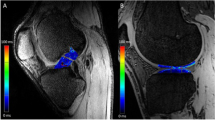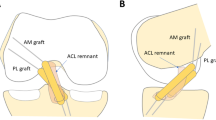Abstract
Objective
The aim of this study was to evaluate, with contrast-enhanced-magnetic resonance imaging (MRI), the changing imaging appearance of an anterior cruciate ligament (ACL) graft during the revascularization phase by quantitatively assessing the morphological and signal intensity changes taking place at its cross-sectional surface over time.
Materials and methods
Fifty patients underwent contrast-enhanced-MRI on the third postoperative day and at a mean of 6, 12, and 24 months time interval after surgery. Proton-density images were obtained to evaluate morphological and signal intensity characteristics. Oblique–axial T1-weighted images obtained before and after intravenous gadolinium administration were used for quantitative analysis. Enhancement index (EI: signal-to-noise quotientafter gadolinium÷signal-to-noise quotientbefore gadolinium) and cross-sectional area (CSA) were calculated for two regions of interest: the transplanted graft and its surrounding hypervascular tissue, and at three distinct graft sites (intra-articular, intraosseous tibial tunnel, and intraosseous juxta screw sites). Comparisons of EI and CSA at every site and time interval were performed using analysis of variance.
Results
A variable MRI appearance of the graft during the different time intervals was attributed to the varying amount of the hypervascular tissue gradually surrounding the graft. Graft EI and peripheral tissue CSA progress in a parallel, time- and site-related pattern along the graft course. The initial heterogeneity with intermediate signal intensity at the intra-articular graft site reflected intense revascularization. A slower revascularization progress was noticed at the other two intraosseously enclosed sites.
Conclusion
During the healing process the amount of revascularization tissue influences the MR imaging characteristics of the graft according to the examined site and the time interval after surgery. By 2 years postoperatively, revascularization completion coincides with the homogeneously low signal intensity of the graft, closely resembling native ACL.








Similar content being viewed by others
References
Dheerendra SK, Khan WS, Singhal R, Shivarathre DG, Pydisetty R, Johnstone D. Anterior cruciate ligament graft choices: a review of current concepts. Open Orthop J. 2012;6(Suppl 2: M4):281–6.
Schindler OS. Surgery for anterior cruciate ligament deficiency: a historical perspective. Knee Surg Sports Traumatol Arthrosc. 2012;20(1):5–47.
Arnoczky SP, Tarvin GB, Marshall JL. Anterior cruciate ligament replacement using patellar tendon. An evaluation of graft revascularization in the dog. J Bone Joint Surg Am. 1982;64(2):217–24.
Clancy Jr WG, Narechania RG, Rosenberg TD, et al. Anterior and posterior cruciate ligament reconstruction in rhesus monkeys. J Bone Joint Surg Am. 1981;63(8):1270–84.
Unterhauser FN, Bail HJ, Höher J, Haas NP, Weiler A. Endoligamentous revascularization of an anterior cruciate ligament graft. Clin Orthop Relat Res. 2003;414:276–88.
Falconiero RP, DiStefano VJ, Cook TM. Revascularization and ligamentization of autogenous anterior cruciate ligament grafts in humans. Arthroscopy. 1998;14(2):197–205.
Rougraff BT, Shelbourne KD. Early histologic appearance of human patellar tendon autografts used for anterior cruciate ligament reconstruction. Knee Surg Sports Traumatol Arthrosc. 1999;7(1):9–14.
Johnson LL. The outcome of a free autogenous semitendinosus tendon graft in human anterior cruciate reconstructive surgery: a histological study. Arthroscopy. 1993;9(2):131–42.
Sckell A, Leunig M, Fraitzl CR, Ganz R, Ballmer FT. The connective-tissue envelope in revascularisation of patellar tendon grafts. J Bone Joint Surg Br. 1999;81(5):915–20.
Ekdahl M, Wang JH, Ronga M, Fu FH. Graft healing in anterior cruciate ligament reconstruction. Knee Surg Sports Traumatol Arthrosc. 2008;16(10):935–47.
White LM, Kramer J, Recht MP. MR imaging evaluation of the postoperative knee: ligaments, menisci, and articular cartilage. Skeletal Radiol. 2005;34(8):431–52.
Ntoulia A, Papadopoulou F, Ristanis S, Argyropoulou M, Georgoulis AD. Revascularization process of the bone-patellar tendon-bone autograft evaluated by contrast-enhanced magnetic resonance imaging 6 and 12 months after anterior cruciate ligament reconstruction. Am J Sports Med. 2011;39(7):1478–86.
Tuite MJ, De Smet AA. MR of the postoperative knee. Top Magn Reson Imaging. 1996;8(1):2–14. Review.
Vogl TJ, Schmitt J, Lubrich J, et al. Reconstructed anterior cruciate ligaments using patellar tendon ligament grafts: diagnostic value of contrast-enhanced MRI in a 2-year follow-up regimen. Eur Radiol. 2001;11(8):1450–6.
Trattnig S, Rand T, Czerny C, Stocker R, Breitenseher M, Kainberger F, et al. Magnetic resonance imaging of the postoperative knee. Top Magn Reson Imaging. 1999;10(4):221–36. Review.
Rak KM, Gillogly SD, Schaefer RA, Yakes WF, Liljedahl RR. Anterior cruciate ligament reconstruction: evaluation with MR imaging. Radiology. 1991;178(2):553–6.
Jansson KA, Karjalainen PT, Harilainen A, Sandelin J, Soila K, Tallroth K, et al. MRI of anterior cruciate ligament repair with patellar and hamstring tendon autografts. Skeletal Radiol. 2001;30(1):8–14.
Irizarry JM, Recht MP. MR imaging of the knee ligaments and the postoperative knee. Radiol Clin North Am. 1997;35(1):45–76. Review.
Saupe N, White LM, Chiavaras MM, et al. Anterior cruciate ligament reconstruction grafts: MR imaging features at long-term follow-up-correlation with functional and clinical evaluation. Radiology. 2008;249(2):581–90.
Ilaslan H, Sundaram M, Miniaci A. Imaging evaluation of the postoperative knee ligaments. Eur J Radiol. 2005;54(2):178–88. Review.
Muramatsu K, Hachiya Y, Izawa H. Serial evaluation of human anterior cruciate ligament grafts by contrast-enhanced magnetic resonance imaging: comparison of allografts and autografts. Arthroscopy. 2008;24(9):1038–44.
Inacio MC, Paxton EW, Maletis GB, Csintalan RP, Granan LP, Fithian DC, et al. Patient and surgeon characteristics associated with primary anterior cruciate ligament reconstruction graft selection. Am J Sports Med. 2012;40(2):339–45.
Shankar SS, Steinberg HO. Obesity and endothelial dysfunction. Semin Vasc Med. 2005;5(1):56–64.
Michaud SE, Dussault S, Haddad P, Groleau J, Rivard A. Circulating endothelial progenitor cells from healthy smokers exhibit impaired functional activities. Atherosclerosis. 2006;187(2):423–32.
Iwakura A, Luedemann C, Shastry S, et al. Estrogen-mediated, endothelial nitric oxide synthase-dependent mobilization of bone marrow-derived endothelial progenitor cells contributes to reendothelialization after arterial injury. Circulation. 2003;108(25):3115–21.
Georgoulis AD, Papageorgiou CD, Makris CA, Moebius UG, Soucacos PN. Anterior cruciate ligament reconstruction with the press-fit technique. 2–5 years followed-up of 42 patients. Acta Orthop Scand Suppl. 1997; Suppl. 275:42–5.
Collins MS, Unruh KP, Bond JR, Mandrekar JN. Magnetic resonance imaging of surgically confirmed anterior cruciate ligament graft disruption. Skeletal Radiol. 2008;37(3):233–43.
Frick MA, Collins MS, Adkins MC. Postoperative imaging of the knee. Radiol Clin North Am. 2006;44(3):367–89. Review.
Obuchowski NA, Lieber ML. Statistics and methodology. Skeletal Radiol. 2008;37(5):393–6.
Tegner Y, Lysholm J. Rating systems in the evaluation of knee ligament injuries. Clin Orthop Relat Res. 1985;198:43–9.
Steiner ME, Brown C, Zarins B, Brownstein B, Koval PS, Stone P. Measurement of anterior-posterior displacement of the knee. A comparison of the results with instrumented devices and with clinical examination. J Bone Joint Surg Am. 1990;72(9):1307–15.
Murakami Y, Sumen Y, Ochi M, Fujimoto E, Deie M, Ikuta Y. Appearance of anterior cruciate ligament autografts in their tibial bone tunnels on oblique axial MRI. Magn Reson Imaging. 1999;17(5):679–87.
Zaffagnini S, De Pasquale V, Marchesini Reggiani L, et al. Neoligamentization process of BTPB used for ACL graft: histological evaluation from 6 months to 10 years. Knee. 2007;14(2):87–93.
Fu FH. What’s new on ACL surgery horizon? Curr Rev Musculoskelet Med. 2011;4(2):35–6.
Wen CY, Qin L, Lee KM, Wong MW, Chan KM. Grafted tendon healing in tibial tunnel is inferior to healing in femoral tunnel after anterior cruciate ligament reconstruction: a histomorphometric study in rabbits. Arthroscopy. 2010;26(1):58–66.
Author information
Authors and Affiliations
Corresponding author
Additional information
The study was performed at the Department of Radiology, the Department of Orthopaedic Surgery and the Orthopaedic Sports Medicine Center, at the University Hospital of Ioannina, Greece
Rights and permissions
About this article
Cite this article
Ntoulia, A., Papadopoulou, F., Zampeli, F. et al. Evaluation with contrast-enhanced magnetic resonance imaging of the anterior cruciate ligament graft during its healing process: a two-year prospective study. Skeletal Radiol 42, 541–552 (2013). https://doi.org/10.1007/s00256-012-1534-y
Received:
Revised:
Accepted:
Published:
Issue Date:
DOI: https://doi.org/10.1007/s00256-012-1534-y




